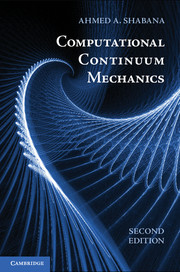Book contents
- Frontmatter
- Contents
- Preface
- 1 Introduction
- 2 Kinematics
- 3 Forces and Stresses
- 4 Constitutive Equations
- 5 Plasticity Formulations
- 6 Finite Element Formulation: Large-Deformation, Large-Rotation Problem
- 7 Finite Element Formulation: Small-Deformation, Large-Rotation Problem
- 8 Computational Geometry and Finite Element Analysis
- References
- Index
Preface
Published online by Cambridge University Press: 05 June 2012
- Frontmatter
- Contents
- Preface
- 1 Introduction
- 2 Kinematics
- 3 Forces and Stresses
- 4 Constitutive Equations
- 5 Plasticity Formulations
- 6 Finite Element Formulation: Large-Deformation, Large-Rotation Problem
- 7 Finite Element Formulation: Small-Deformation, Large-Rotation Problem
- 8 Computational Geometry and Finite Element Analysis
- References
- Index
Summary
Nonlinear continuum mechanics is one of the fundamental subjects that form the foundation of modern computational mechanics. The study of the motion and behavior of materials under different loading conditions requires understanding of basic, general, and nonlinear kinematic and dynamic relationships that are covered in continuum mechanics courses. The finite element method, on the other hand, has emerged as a powerful tool for solving many problems in engineering and physics. The finite element method became a popular and widely used computational approach because of its versatility and generality in solving large-scale and complex physics and engineering problems. Nonetheless, the success of using the continuum-mechanics-based finite element method in the analysis of the motion of bodies that experience general displacements, including arbitrary large rotations, has been limited. The solution to this problem requires resorting to some of the basic concepts in continuum mechanics and putting the emphasis on developing sound formulations that satisfy the principles of mechanics. Some researchers, however, have tried to solve fundamental formulation problems using numerical techniques that lead to approximations. Although numerical methods are an integral part of modern computational algorithms and can be effectively used in some applications to obtain efficient and accurate solutions, it is the opinion of many researchers that numerical methods should only be used as a last resort to fix formulation problems. Sound formulations must be first developed and tested to make sure that these formulations satisfy the basic principles of mechanics. The equations that result from the use of the analytically correct formulations can then be solved using numerical methods.
This book is focused on presenting the nonlinear theory of continuum mechanics and demonstrating its use in developing nonlinear computer formulations that can be used in the large displacement dynamic analysis. To this end, the basic concepts used in continuum mechanics are first presented and then used to develop nonlinear general finite element formulations that can be effectively used in the large displacement analysis. Two nonlinear finite element dynamic formulations will be considered in this book. The first is a general large-deformation finite element formulation, whereas the second is a formulation that can be used efficiently to solve small-deformation problems that characterize very and moderately stiff structures. In this latter case, an elaborate method for eliminating the unnecessary degrees of freedom must be used to be able to efficiently obtain a numerical solution. An attempt has been made to present the materials in a clear and systematic manner with the assumption that the reader has only basic knowledge in matrix and vector algebra as well as basic knowledge of dynamics. The book is designed for a course at the senior undergraduate and first-year graduate level. It can also be used as a reference for researchers and practicing engineers and scientists who are working in the areas of computational mechanics, biomechanics, computational biology, multibody system dynamics, and other fields of science and engineering that are based on the general continuum mechanics theory.
- Type
- Chapter
- Information
- Computational Continuum Mechanics , pp. ix - xiiPublisher: Cambridge University PressPrint publication year: 2011

